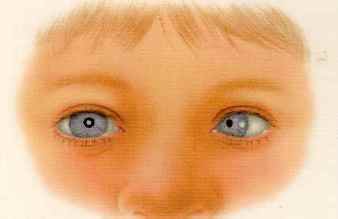
Figure: Strabismic Amblyopia
2. What are the behavioral consequences of an under-developed or abnormally developed visual system?
During childhood, the visual system grows and develops at the same time that the brain matures, a process that takes about ten years. While babies are capable of seeing, their vision is poor at first and limited to a vision of about 20/1500. This is due to the brain not maturing yet to the level where it is able to learn to process the visual information that it receives. As the visual system further develops, vision will become clearer and will develop so that the child will eventually be able to see the slightest details of an image. However, the visual system of some children becomes underdeveloped or abnormally developed causing them to have visual disorders. Oftentimes these visual disorders are related to brain disorders that are also present within the child. Some types of vision problems include cortical blindness, delayed visual maturation, optic nerve hypoplasia, optic nerve atrophy, cranial neuropathies, along with many others.
One commonly seen disorder from an underdeveloped visual system is amblyopia, also known as “lazy eye,” in which the visual function of one eye is underdeveloped while the vision of the other eye functions normally. Any factor that prevents or inhibits clear vision during childhood can promote amblyopia. Some of the chief causes of amblyopia, which are abnormal developments in themselves, are strabismus (misalignment of the eyes), unequal focus due to an asymmetrical refractive error, and cloudiness in normally clear eye tissues such as corneal opacities and cataracts which prevent correct focus of light in the eye.
Another visual defect that was already mentioned above is strabismus in which the eyes develop misaligned and point in different directions. This disorder is often most common among children but is also seen in about 2 percent of the adult population also. Because of the eye misalignment, the brain receives two different visual messages. In children, the brain will often disregard or not put as much emphasis on the image sent by the diverging eye while still processing highly detailed visual information from the straight eye. This improper functioning results in amblyopia causing one eye to become “lazy.” Strabismus is also commonly associated with defective or absent binocular vision, which is characterized by reduced 3-D vision, resulting in impaired depth perception. As the visual system further develops into adulthood, strabismus may cause double vision, eye strain, discomfort in reading, and headaches. Adult who develop strabismus with no prior history of childhood strabismus may have medical or neurological causes of the defect which may be due to diabetes, thyroid disease, myasthenia gravis, brain tumor, or stroke.
Although I have only mentioned two defects caused by an underdeveloped or abnormally developed visual system there are a number of other disorders. Many minor defects such as myopia or hyperopia can lead to blurry and unclear vision but can be corrected through corrective lenses or refractive surgery. Other disorders such as glaucoma or retinopathy of prematurity can cause blindness while others such as retinoblastoma, a form of cancer, can eventually lead to death. The large number of defects and disorders caused by an under- or abnormally developed nervous system are also accompanied with a vast number of consequences. Heredity, genetics, nutrition, environmental toxins, stress, problems at birth, or insufficient sensory stimulation can all be blamed as causes for these disorders or defects and the results that they produce.
(Citation: http://www.bpei.med.miami.edu/site/disease/disease_pediatric.asp)
Leave a comment